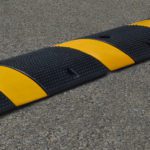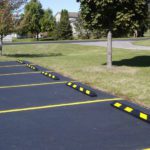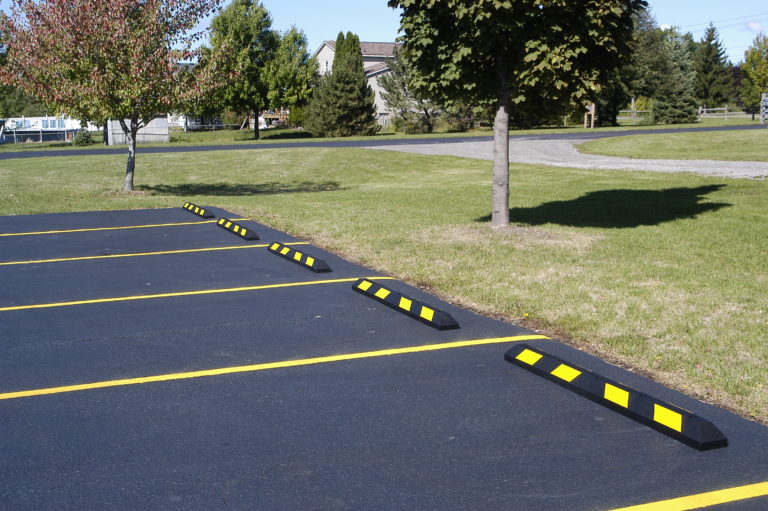Installing Rubber Speed Bumps: Parking lots, construction sites, security guard gates… There are a number of places where it may be necessary to prevent people from speeding past your property with speed bumps.

Asphalt, concrete, plastic, and metal are the most common materials used to construct speed bumps. However, rubber speed bumps seem to have a number of advantages over other materials. In addition to being cost-effective and ecologically sustainable, they are suited for use on all types of pavements and can help improve overall visibility.
Rubber speed bumps are also highly practical and relatively easy to install — you will only need a few readily available tools and an hour of your time to complete this project.
The first step in installing a rubber speed bump is choosing the most appropriate location for the speed bump to be installed. It could be a long stretch of unbending road where people tend to drive at excessive speeds.
For example, the parking lot outside an ice cream shop, a child care facility, or a candy store may be an area where you would like drivers to exercise extra caution when approaching small children who may dart out into the path of oncoming traffic. Despite the fact that private back lots can gradually become unregulated shortcuts, a few high-speed bumps along the way could make that option less appealing right away.
 If you have a particular landmark you want to protect, such as a crosswalk or a security guard cabin, you should install your rubber speed bump several yards away from it to allow traffic enough time to slow down.
If you have a particular landmark you want to protect, such as a crosswalk or a security guard cabin, you should install your rubber speed bump several yards away from it to allow traffic enough time to slow down.
When determining the placement of a rubber speed bump, consider putting a sign to alert incoming traffic of the bump — giving drivers a heads-up that a speed bump is ahead would be welcomed and minimize driver frustration. This is critical because community support for speed bumps allows you to install them where they are needed the most.
It is time to get down to business with the actual installation. Here’s what you will need:
- Four lag screws of the appropriate size for the holes in the rubber speed bump
- Hammer drill
- Sledgehammer
- If you are working in a busy area, enough traffic cones to notify oncoming vehicles that you are working on the roadside
The following are the steps for installing rubber speed bumps:
 Ensure the area where the rubber speed bump will be installed is clean. The life of the speed bump will be significantly reduced if there is debris trapped between the bump and the pavement. To clear any debris from the surface, you can use a pressure washer, a gas leaf blower, or even a broom.
Ensure the area where the rubber speed bump will be installed is clean. The life of the speed bump will be significantly reduced if there is debris trapped between the bump and the pavement. To clear any debris from the surface, you can use a pressure washer, a gas leaf blower, or even a broom.- Next, using the hammer drill, drive the appropriate-sized bit straight down into the asphalt through the pilot holes in the bump. The depth of these holes should be several inches.
- If the holes have expelled a large amount of excess debris, remove the speed bump, clean the surface, and then replace it.
- Your rubber speed bump should be delivered with reinforcing steel bars or bolts that have been custom-designed to fit the bump. Sledgehammers can be used to drive these into the ground. Make sure these are driven as deep as they can go — they must be deeper than the holes they are in, or they will damage the tires of cars driving over the speed bump.
A few minutes should be sufficient to complete the process.
If you would like to learn more about rubber speed bumps or receive a quote for some high-quality rubber speed bumps, contact a local contractor today.
Contact us for Rubber Speed Bumps
Address
Commonwealth Paving, 136 Outerloop, Louisville, Kentucky 40214
Phone: 502-459-7283, Fax: 502-456-2678
Opening Hours
| Monday | 9:00 AM – 5:00 PM |
| Tuesday | 9:00 AM – 5:00 PM |
| Wednesday | 9:00 AM – 5:00 PM |
| Thursday | 9:00 AM – 5:00 PM |
| Friday | 9:00 AM – 5:00 PM |
| Saturday | Closed |
| Sunday | Closed |







